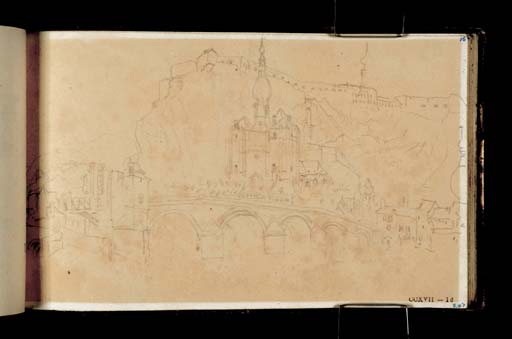Joseph Mallord William Turner The Citadel, Church of Notre-Dame and Bridge over the Meuse at Dinant, Looking Downstream from the West Bank 1824
Image 1 of 2
-
 Joseph Mallord William Turner, The Citadel, Church of Notre-Dame and Bridge over the Meuse at Dinant, Looking Downstream from the West Bank 1824
Joseph Mallord William Turner, The Citadel, Church of Notre-Dame and Bridge over the Meuse at Dinant, Looking Downstream from the West Bank 1824 -
 Joseph Mallord William Turner, The Citadel, Church of Notre-Dame and Bridge over the Meuse at Dinant, Looking Downstream from the West Bank 1824 (Enhanced image)Enhanced image
Joseph Mallord William Turner, The Citadel, Church of Notre-Dame and Bridge over the Meuse at Dinant, Looking Downstream from the West Bank 1824 (Enhanced image)Enhanced image
Joseph Mallord William Turner,
The Citadel, Church of Notre-Dame and Bridge over the Meuse at Dinant, Looking Downstream from the West Bank
1824
Joseph Mallord William Turner 1775–1851
Folio 16 Recto:
The Citadel, Church of Notre-Dame and Bridge over the Meuse at Dinant, Looking Downstream from the West Bank 1824
D20109
Turner Bequest CCXVII 16
Turner Bequest CCXVII 16
Pencil on off-white wove paper, 99 x 162 mm
Watermark ‘[...]lls | 1[...]’
Inscribed in pencil by Turner ‘White’ centre right, ‘yellow’ towards bottom right
Inscribed in blue ink by Ruskin ‘16’ top right and ‘247’ bottom right
Stamped in black ‘CCXVII–16’ bottom right
Watermark ‘[...]lls | 1[...]’
Inscribed in pencil by Turner ‘White’ centre right, ‘yellow’ towards bottom right
Inscribed in blue ink by Ruskin ‘16’ top right and ‘247’ bottom right
Stamped in black ‘CCXVII–16’ bottom right
Accepted by the nation as part of the Turner Bequest 1856
Exhibition history
1904
National Gallery, London, various dates to at least 1904 (601k, as ‘Ten Leaves from a Book of Sketches on the Rhine and Meuse’).
References
1904
E.T. Cook and Alexander Wedderburn eds., Library Edition: The Works of John Ruskin: Volume XIII: Turner: The Harbours of England; Catalogues and Notes, London 1904, pp.302, 636 no.601k, as ‘Ten Leaves from a Book of Sketches on the Rhine and Meuse’.
1909
A.J. Finberg, A Complete Inventory of the Drawings of the Turner Bequest, London 1909, vol.II, p.682, as ‘Dinant’.
1975
Malcolm Cormack, J.M.W. Turner, R.A. 1775–1851: A Catalogue of Drawings and Watercolours in the Fitzwilliam Museum, Cambridge, Cambridge 1975, p.64 no.41 note 1, [p.68].
1991
Cecilia Powell, Turner’s Rivers of Europe: The Rhine, Meuse and Mosel, exhibition catalogue, Tate Gallery, London 1991, p.41 note 18, [p.60].
This is the first in a series of four intricate studies of Dinant, a Belgian town located on the Meuse thirty kilometres south of Namur (for the others see Tate D20110–D20113; Turner Bequest CCXVII 17–19). Turner’s rendering of the scene here is exactly as the journalist and author Dudley Costello described: ‘the situation of Dinant is in the highest degree picturesque... Below the bridge the houses are built close to the river, and above it are separated only by a long quay, planted with trees, which serves for recreation as well as commerce’.1 Costello also writes of a ‘spacious market place’ at the foot of the bridge next to the Collegiate Church of Notre-Dame, which is shown here with its strikingly bulbous onion-domed spire and lantern.2 The viewer will notice that this shape is echoed, albeit in rather squatter proportions, in the spire of the Porte Saint-Martin, a city gate, at far right. Turner has inscribed what appear to be notes on colours (‘white’ and ‘yellow’) close to the bottom right of the church and within one of the houses at the foot of the bridge.
Dinant is ‘backed by a steep ridge’, a rock ‘wild and bare’ surmounted by a citadel, which is recorded here in this drawing.3 The ‘formidable fortress’, as Costello calls it, was constructed in the twelfth century and remodelled by the French and Dutch. It rises perpendicularly from the plateau commanding ‘all the approaches to the town’ in a manner which ‘appears to laugh a siege to scorn’.4
For other 1824 drawings of Dinant, see those in the Rivers Meuse and Moselle (Tate D19554, D19559, D19654–D19657, D19659, D19662–D19663; Turner Bequest CCXVI 2, 4a, 52a–54, 55, 56a–57). For later views, particularly sketches taken in 1839, see Tate D28094, D28122, D28125, D28142, D28147, D28153, D28155–D28158, D28160–D28166, D41091; Turner Bequest CCLXXXVII 27a, 42a, 44a, 53, 56a, 59a, 60a–62a, 63a–66a. There is also a series of colour drawings executed in gouache and watercolour: Tate D20227, D20228, D24724, D28984; Turner Bequest CCXX T, U; CCLIX 159, CCXCII 37.
Dudley Costello, A tour through the valley of the Meuse: with the legends of the Walloon country and the Ardennes, London 1846, pp.207–8.
Ibid; see also ‘The Citadel’s History’, La Citadelle Dinant, accessed 23 January 2014, http://www.citadellededinant.be/en/tourism-history
Technical notes:
The paper has mottled and browned significantly, a result of the drawing’s prolonged exhibition and exposure to sunlight during the nineteenth century.
Verso:
Blank
Alice Rylance-Watson
January 2014
How to cite
Alice Rylance-Watson, ‘The Citadel, Church of Notre-Dame and Bridge over the Meuse at Dinant, Looking Downstream from the West Bank 1824 by Joseph Mallord William Turner’, catalogue entry, January 2014, in David Blayney Brown (ed.), J.M.W. Turner: Sketchbooks, Drawings and Watercolours, Tate Research Publication, April 2015, https://www

